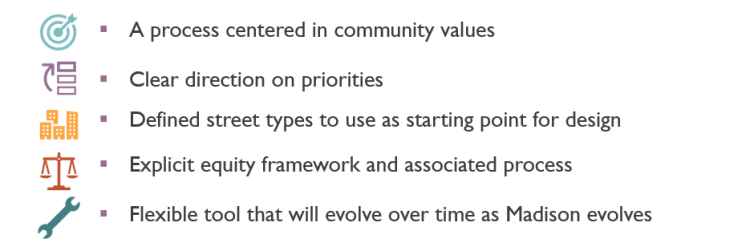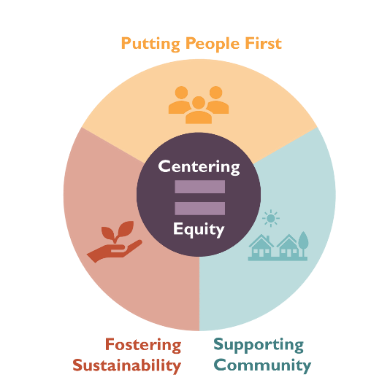Complete Green Streets
Streets in Madison move people, but are also our largest public spaces. Safe, connected, and resilient streets are critical to the quality of life, health, and mobility of residents and visitors to the City of Madison. Streets play an important role in moving people and goods, supporting environmental sustainability, fostering economic activity and facilitating a wide array of uses and activities. The importance of these spaces requires a design approach that considers that multiple roles that streets serve.
Madison has a history of designing streets to accommodate all modes of travel and developing and maintaining a safe, efficient, economical, equitable, and sustainable transportation system for Madison's residents and visitors. In 2009, the City of Madison reaffirmed the City’s commitment to Complete Streets in Resolution 09-00997 and directed staff to follow to the extent possible Complete Streets concepts.
This Complete Green Streets Guide will provide a more detailed framework for implementing Complete Streets while also considering the green infrastructure needed to address sustainability goals. In 2022, the City adopted a Vision Zero Action Plan with a goal to eliminate serious and fatal traffic crashes and this guide prioritizes safety for all users over high speeds for those who choose to drive. This guide supports Vision Zero in that safety for all users is prioritized.
Complete Green Streets Approach
The Complete Green Streets approach provides a consistent process for planning, designing, building, and operating streets in a way that better reflects our community values and increases safety and equity. When we use the word “street,” we are referring to the sidewalks, terraces, roadway, and everything in between. Complete Green Streets provides:

Street values shape how we make decisions and what we prioritize in our transportation system. These values guide decisions related to the design, operation, and use of streets and transportation in the City of Madison.

Through our engagement we heard:
- Putting people first: prioritize safety, comfort, and well-being which de-emphasizes speed and convenience
- Supporting community: create safe, welcoming places and emphasize short trips and access to local destinations
- Fostering sustainability: promote walking, biking, and transit and use streets to expand the urban tree canopy and clean stormwater
- Centering equity: engage inclusively, provide access to opportunities, prioritize, and support the needs of historically underserved people (race, culture, age, income, and gender identity)
The modal hierarchy below illustrates the order in which various travel modes are accommodated by default. It is a way of translating street values into design decisions.

For example, our “putting people first” value means prioritizing the safety and comfort of people walking and using wheelchairs. On some streets, the priority of uses will be different, based on context and overlays. This hierarchy represents the default starting point and broad city policy.
Frequently Asked Questions
Community Engagement
Engagement for the Complete Green Streets guide is part of the Let’s Talk Streets initiative, which focuses on better understanding community values and applying those to transportation initiatives.
| Project Materials | |
|---|---|
Complete Green Streets Guide
| Guide |
| Enhanced Distributed Green Infrastructure & Tree Canopy Guidance Report December 8, 2022 | Appendix E: ROW Tree Canopy Map |
| Engagement & Equity Framework | Summary Document |
| Let’s Talk Streets Overview Video May 2021 | |
| Street Stats April 2021 | Maps & Data |
| Board, Committee & Commission Meeting Materials | |
|---|---|
| Board of Public Works Nov 2, 2022 | Overview of Process Presentation |
| Transportation Policy & Planning Board Oct 24, 2022 | Engagement, Equity, Green Infrastructure and Design Details Presentation |
| Transportation Policy & Planning Board Aug 15, 2022 | |
| Transportation Policy & Planning Board Feb 14, 2022 | Engagement, Equity and Modal Priorities Presentation |
| Transportation Policy & Planning Board Nov 14, 2022 | Process Overview |
| Transportation Policy & Planning Board Oct 18, 2021 | Engagement and Street Typology Presentation |
| Transportation Policy & Planning Board Aug 16, 2021 | Engagement, Modal Hierarchy & Foundation Presentation |
| Transportation Policy & Planning Board May 17, 2021 | Engagement & Street Stats Presentation |
| Transportation Policy & Planning Board April 19, 2021 | Engagement & Disparities Presentation |
